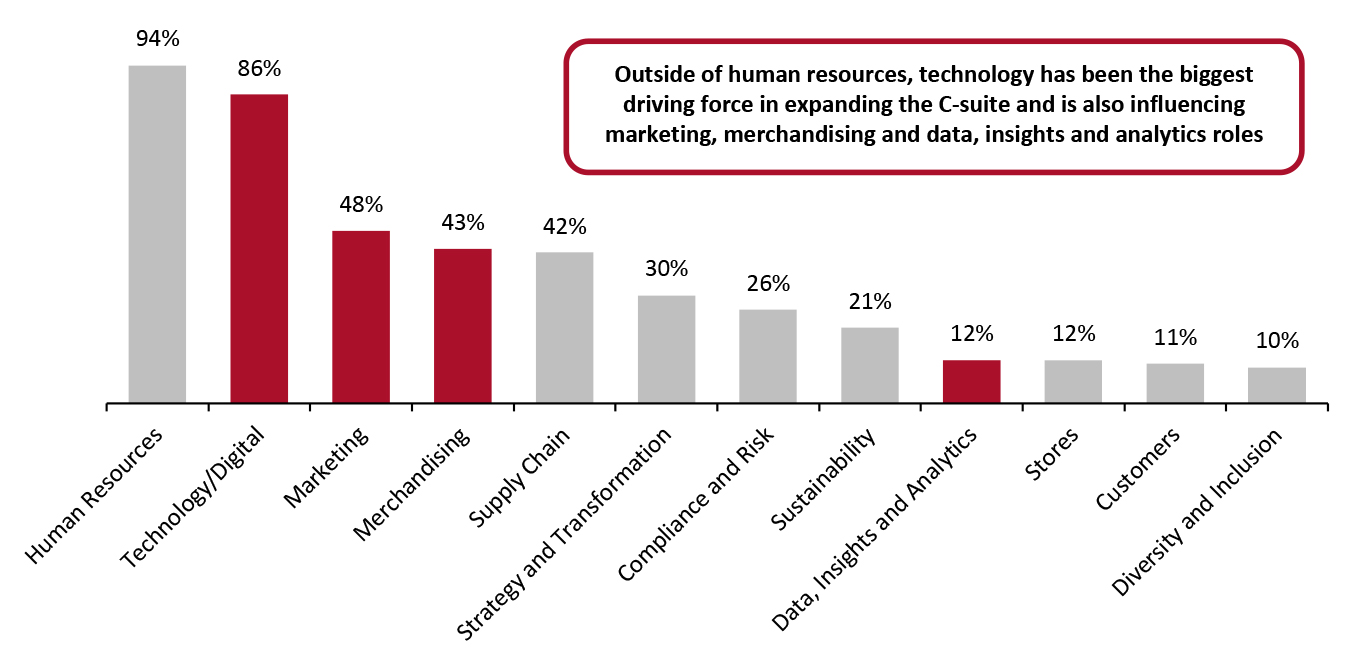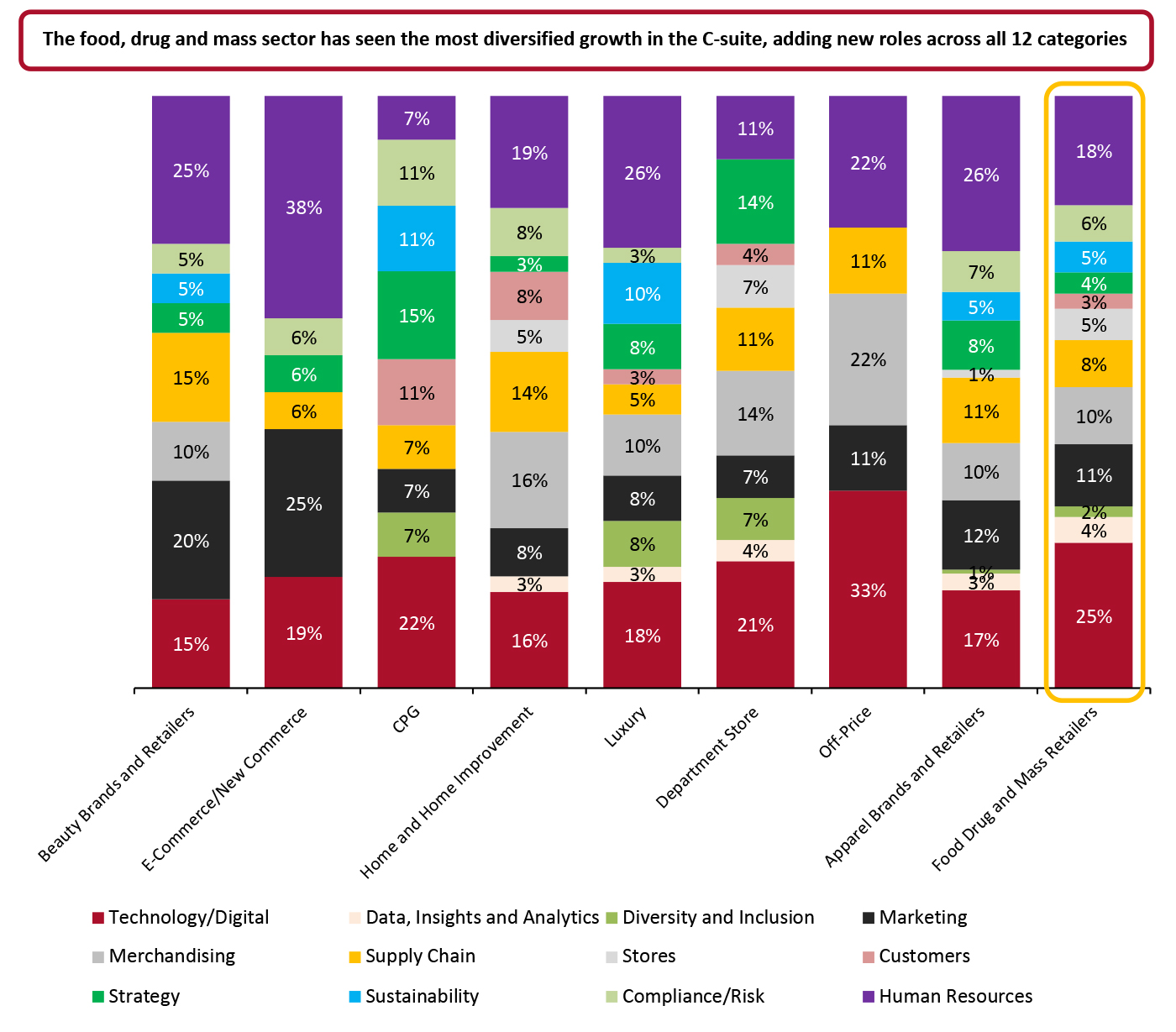
DIpil Das
Introduction
What’s the Story?The C-suite, or senior executive-level leadership team within a company (“chief x officer”), works to set the company’s strategies and make high-level decisions to ensure that the company is meeting its established goals. The C-suite has expanded over the past 20 years to account for and reflect the evolution and changes happening in the industry and society.
In this report, we analyze the current C-suite of the Coresight 100 (C100), our focus list of influential public companies spanning nine sectors in retail and consumer goods, to discern sector and industry trends. The C100 sectors are apparel brands and retailers, beauty brands and retailers, consumer packaged goods (CPG) companies, department stores, e-commerce companies, food, drug and mass retailers, home and home-improvement retailers, luxury brands and off-price retailers.
We frame our analysis according to 12 major categories that we have identified as influencing the expansion of the C-suite. We present insights into the C-suite by sector and by role to report on which sectors and categories are seeing the highest growth. Finally, we provide our outlook for the C-suite of the future.
Why It MattersWe see the C-suite evolving: it has become larger and more complex to adjust to modern times, meaning that companies will have to account for a bigger number of core individuals making decisions. The Covid-19 pandemic has required that companies adapt and pivot quickly, leading them to focus on forward-looking positions in the C-suite, such as strategy and transformation roles.
The C-Suite’s Evolution: Coresight Research Analysis
1. The C-Suite Is Growing, with Social, Technology and Industry DevelopmentsThe C-suite used to have a simpler structure, comprising the chief executive officer (CEO), chief financial officer (CFO), chief operating officer (COO) and an executive for investor relations. This structure needed to expand to incorporate advancements and innovations as well as operating in a global retail world. For example, the digital age and e-commerce were in their infancy 20 years ago.
Coresight Research analyzed the C100 to determine which roles were most prevalent. As part of our analysis, we assume as a baseline that each C100 company C-suite had a CEO, CFO, COO and investor relations position. In the C100, we identified 435 new C-suite roles (added in the past 20 years) across 12 categories:
- Human resources
- Technology/digital
- Marketing
- Merchandising
- Supply chain
- Strategy and transformation
- Compliance and risk
- Sustainability
- Data, insights and analytics
- Stores
- Customers
- Diversity and inclusion
Companies are increasingly adding a seat at the C-suite table for human resources, with 94% of C100 companies reporting an executive role that includes chief human resources officer, chief people officer and other expanded executive human resource titles such as chief talent officer and chief experience officer.
Advancements in technology have had a significant impact on the C-Suite, as 86% of C100 companies have executive roles including a chief information officer, chief technology officer or chief digital officer. In addition, 12% are focusing on data, insights and analytics; this is increasingly an integral decision-making function for organizations. Technology has also impacted other functions: there is a growing need for companies to have chief marketing officer and chief merchandising officer roles due to the proliferation of technology and social platforms, with retailers requiring consistent brand messaging across all retail platforms.
Social developments are affecting organizations both internally and externally. For example, sustainability is a social impact that companies are addressing with their own sustainability plans for their workspaces, buildings and deliveries. Sustainability impacts the entire product lifecycle in terms of design, manufacturing, packaging, sourcing and product inputs. We expect that, with recent supply chain disruption, more companies will look to add a chief supply chain officer role.
In Figure 1, we show a breakdown of the C100 companies’ additions to their C-suites in the past 20 years by the 12 identified role categories.
Figure 1. C100 Companies: New C-Suite Roles*, by Category (% of Companies) [caption id="attachment_153790" align="aligncenter" width="700"]
 *Roles added in the past 20 years at C-suite executive level, excluding CEO, CFO, COO and Investor Relations. Examples of titles start with “Chief of” or “Senior Vice President of” or “President of”
*Roles added in the past 20 years at C-suite executive level, excluding CEO, CFO, COO and Investor Relations. Examples of titles start with “Chief of” or “Senior Vice President of” or “President of” Source: S&P Capital IQ/Coresight Research [/caption]
In Figure 2, we highlight major technology, industry and social developments over the past 20 years, and examples of the corresponding roles and responsibilities in the C-suite.
Figure 2. Factors Influencing C-Suite Role Expansion and C-Suite Titles [wpdatatable id=2197 table_view=regular]
Source: S&P Capital IQ/Coresight Research
2. Department Stores’ C-Suite Growth Outpaces Other Sectors
Our analysis indicates that each company in the C100 has added 4.3 C-suite roles (outside of the traditional roles of CEO, CFO, COO and Investor Relations) on average, across the 12 identified major categories of roles.
- The department store sector (comprising only four department store retailers) has expanded by 25 positions across nearly every major category, averaging 7.0 new C-suite roles per company.
- The off-price sector has remained the most traditional in its C-suite composition, expanding in digital, human resources, merchandising, marketing and supply chain. The sector has added an average of 3.0 new C-suite roles per company.
- Apparel brands and retailers—forming the largest C100 sector with 38 companies—has seen relatively slower C-suite growth than other sectors, averaging 3.8 new roles per company.
Figure 3. C100 Companies: New C-Suite Roles*, by Sector [caption id="attachment_153791" align="aligncenter" width="700"]
 *Roles added in the past 20 years at C-suite executive level, excluding CEO, CFO, COO and Investor Relations. Examples of titles start with “Chief of” or “Senior Vice President of” or “President of”
*Roles added in the past 20 years at C-suite executive level, excluding CEO, CFO, COO and Investor Relations. Examples of titles start with “Chief of” or “Senior Vice President of” or “President of” Source: S&P Capital IQ/Coresight Research [/caption]
3. Food, Drug and Mass Market Sector Has Most Diversified C-Suite Growth
Below, we discuss sector-specific trends that are influencing C-suite growth across the 12 categories of roles.
- Food, drug and mass retailers have expanded their C-suites in the most diverse way, adding roles across all 12 categories—the only sector to have done so.
- All C100 sectors have added a C-suite role in four categories: digital, human resources, marketing and supply chain.
- In the digital category, the department store and food, drug and mass retail sectors have added more than one digital officer per company, on average.
- Eight of the nine sectors grew their C-suite with roles in strategy and transformation; off-price was the only sector that did not expand its C-suite with this position.
- Sustainability, diversity and inclusion, and data, insights and analytics are among the least penetrated categories: each category was represented in the new C-suite roles of only five of the nine C100 sectors. We expect more roles in these three areas to be added in the future as companies increasingly incorporate sustainability, diversity and technology into their corporate strategies.
- The least penetrated category was stores, with only four of the nine sectors adding a chief of stores officer: home and home improvement; department stores; apparel brands and retailers; and food, drug and mass retailers.
- Human resources is a category where companies are taking different strategies on the role name; 46% of C100 companies have added chief human resources officers, 65% have added chief people officers, and 7% have added other titles including chief talent officers, chief experience officers and chief experience officers.
In Figure 4, we show the breakdown the C100 companies’ additions to their C-suites in the past 20 years by the 12 identified role categories for each sector.
Figure 4. C100 Companies: Breakdown of New C-Suite Roles*, by Category and Sector (% of New Roles) [caption id="attachment_153792" align="aligncenter" width="700"]
 *Roles added in the past 20 years at C-suite executive level, excluding CEO, CFO, COO and Investor Relations. Examples of titles start with “Chief of” or “Senior Vice President of” or “President of”
*Roles added in the past 20 years at C-suite executive level, excluding CEO, CFO, COO and Investor Relations. Examples of titles start with “Chief of” or “Senior Vice President of” or “President of” Source: S&P Capital IQ/Coresight Research [/caption] 4. Across the C100, 16.5% of CEOs and CFOs Are Women
In 2022, there was a record number of female CEOs at the Fortune 500 companies, totaling 74—comprising approximately 15% of all CEOs—up from only seven women in 2002. Our analysis of the C100 companies reflect a similar metric: we found that women hold 14% of CEO positions. In addition, women account for 19% of CFO positions.
In Figure 6, we combine the sectors’ CEOs and CFOs to provide an overview of the gender balance in the C100 leadership teams, by sector. Overall, 16.5% of CEO/CFO positions are held by women.
- Beauty, department stores and home/home improvement have the highest proportions of female CEOs/CFOs, of 40%, 38% and 21%, respectively.
Figure 5. C100 Companies by Sector: CEO and CFO Roles, by Gender (% of Roles) [caption id="attachment_153793" align="aligncenter" width="700"]
 Source: S&P Capital IQ/Coresight Research[/caption]
5. C-Suite Focuses on Data, Security and Wellness Because of Hybrid Work
Source: S&P Capital IQ/Coresight Research[/caption]
5. C-Suite Focuses on Data, Security and Wellness Because of Hybrid Work
Working from home (WFH) and hybrid working are the biggest societal changes that are influencing the C-suite. Companies are investing in bolstering data security and privacy as employees are working in hundreds of different locations as compared to one central location. We expect there to be a continued focus on data security and privacy.
As employees are working remotely, there has been a lot of focus on how to balance employee workload with wellbeing. This emphasis on consumer health and wellness is giving rise to new roles such as chief wellness officer.
While none of the C100 companies have yet added a chief wellness officer, Australian company Woolworths has had a chief medical officer and MD of format and network since 2020. The company describes Dr. McCartney, who holds the role as “a specialist occupational physician with experience in providing occupational medical services to a wide range of industry to maximize the health, wellbeing and productivity of working people.”
What We Think
Technology and digital have had the most influence on the C-suite’s growth and we expect this to continue, in two areas in particular:
- With hybrid working models becoming prevalent amid the pandemic and looking set to continue, privacy, security and data will remain a key area of focus for the C-suite.
- With the growing use of artificial intelligence and the ability to use data to make decisions across the supply chain from inventory management, pricing, buying and sourcing, we expect that the C-suite will expand in the data, insights and analytics category.
Across social impact categories, we expect that sustainability and diversity will both become more prominent role categories in the C-suite as they affect internal and external stakeholders and strategic goals.
As hybrid work is becoming the new normal, we expect to see the C-suite continue to add roles that focus on employee wellbeing and retention.
Implications for Brands and Retailers
- As human resources was the highest-growth C-suite category across the C100 companies, we anticipate that companies will prioritize their employees’ wellbeing in the new hybrid-work world through the implementation of new C-suite roles such as chief wellness officers.
- We expect brands and retailers to invest in chief data officers, chief information security officers, chief data security officers or chief intellectual property officers as data security is a core focus area for every company.
- We expect chief analytics officer to become a core C-Suite role as companies rely on advanced data sets and artificial intelligence to make decisions across the business.
- We expect that companies will continue to add socially driven C-suite officers, such as chief of sustainability and chief of diversity and inclusion, with missions that impact the company’s internal organization and external stakeholders and products.